Garibaldi, Hypsypops rubicundus
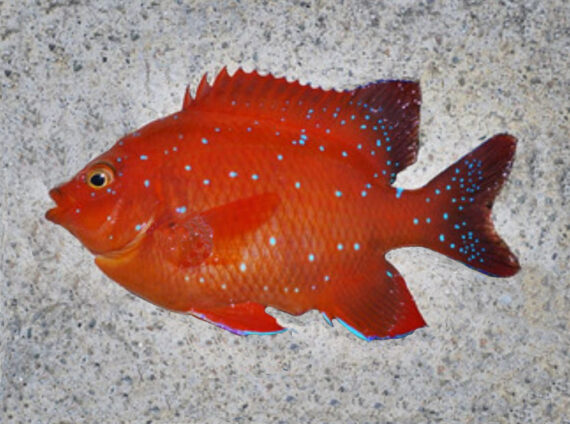 Garibaldi, Hypsypops rubicundus, Juvenile. An accidental catch and release with fish caught out of coastal waters off San Pedro, California, October 2015. Length: 20 cm (7.9 inches). Catch, photograph and identification courtesy of Eli (obsessiveangling.wordpress.com).
Garibaldi, Hypsypops rubicundus, Juvenile. An accidental catch and release with fish caught out of coastal waters off San Pedro, California, October 2015. Length: 20 cm (7.9 inches). Catch, photograph and identification courtesy of Eli (obsessiveangling.wordpress.com).
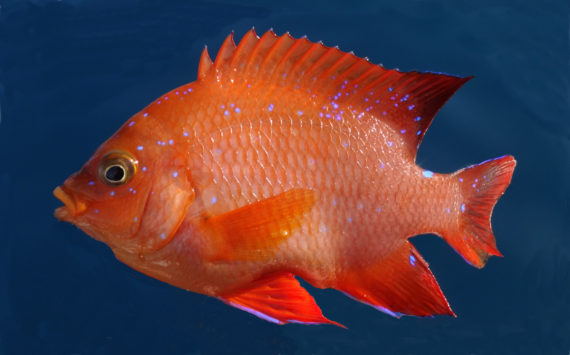 Garibaldi, Hypsypops rubicundus, Juvenile. An accidental catch and release with fish caught out of coastal waters off Newport Beach, California, October 2015. Catch, photograph and identification courtesy of Ben Cantrell, Peoria, Illinois.
Garibaldi, Hypsypops rubicundus, Juvenile. An accidental catch and release with fish caught out of coastal waters off Newport Beach, California, October 2015. Catch, photograph and identification courtesy of Ben Cantrell, Peoria, Illinois.
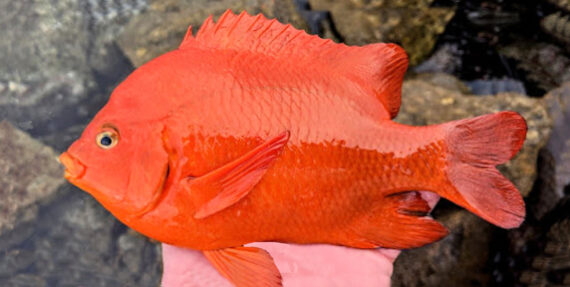 Garibaldi, Hypsypops rubicundus. An accidental catch and release with fish caught out of Mission Bay, San Diego, California, January 2019. Length: 13 cm (5.1 inches). Catch, photograph and identification courtesy of Marc Eberlein, Grand Rapids, Michigan.
Garibaldi, Hypsypops rubicundus. An accidental catch and release with fish caught out of Mission Bay, San Diego, California, January 2019. Length: 13 cm (5.1 inches). Catch, photograph and identification courtesy of Marc Eberlein, Grand Rapids, Michigan.
 Garibaldi, Hypsypops rubicundus. An accidental catch and release with fish caught out of coastal waters off Long Beach, California, October 2015. Catch, photograph and identification courtesy of Chris Wheaton, Fullerton, California.
Garibaldi, Hypsypops rubicundus. An accidental catch and release with fish caught out of coastal waters off Long Beach, California, October 2015. Catch, photograph and identification courtesy of Chris Wheaton, Fullerton, California.
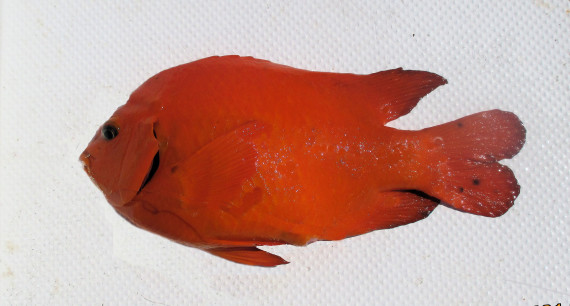 Garibaldi, Hypsypops rubicundus. An accidental catch and release with fish caught out of coastal waters off La Bocana, Baja California Sur, April 2016. Length: 26 cm (10 inches). Catch and photograph courtesy of George Brinkman, Guelph, Ontario, Canada.
Garibaldi, Hypsypops rubicundus. An accidental catch and release with fish caught out of coastal waters off La Bocana, Baja California Sur, April 2016. Length: 26 cm (10 inches). Catch and photograph courtesy of George Brinkman, Guelph, Ontario, Canada.
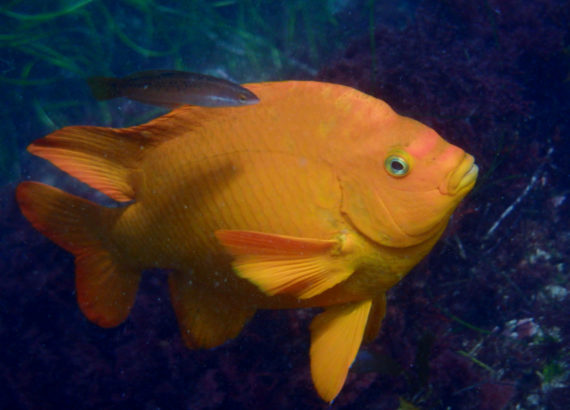 Garibaldi, Hypsypops rubicundus. Underwater photograph taken in coastal waters off La Jolla, California, October 2014. Length: 25 cm (10 inches). Also pictured is a Señorita, Oxyjulis californica. Photograph and identification courtesy of Bob Hillis, Ivins, Utah.
Garibaldi, Hypsypops rubicundus. Underwater photograph taken in coastal waters off La Jolla, California, October 2014. Length: 25 cm (10 inches). Also pictured is a Señorita, Oxyjulis californica. Photograph and identification courtesy of Bob Hillis, Ivins, Utah.
The Garibaldi, Hypsypops rubicundus, is the largest member of the Damselfish or Pomacentridae Family, and is known in Mexico as juqueta garibaldi. The Garibaldi is the State Marine Fish of California and was named after Giuseppe Garibaldi, an Italian military and political figure of the 19th century, who wore a bright red shirt as his trademark. This is the only global member of the genus Hypsypops, which is found in Mexican waters of the Pacific Ocean.
The Garibaldi has a deep oblong thick compressed body that has a depth that is 49% to 53% of standard length. They are the most distinctive fish on the California Coast with juveniles being reddish-orange in color with numerous blue spots scattered across their body and fins. As the juveniles mature, they transition to bright orange and lose their blue spots. Adult females and males are similarly colored. All their fins have faint blue margins and their eyes are yellow. Their caudal and pectoral fins are long and flowing. They have a small mouth with a single row of chisel-like teeth, large lips, and a steeply sloping head featuring an enlarged crest in mature males. Their anal fin has 2 spines and 12 to 15 rays; their caudal fin is deeply notched with both lobes being large and rounded; and their dorsal fin has 11 to 13 spines and 15 to 17 rays. They have 15 gill rakers. They are covered with large scales. Their lateral line is incomplete ending under their dorsal fin base.
The Garibaldi is a solitary non-schooling non-migratory species found in clear water environments around rocky inshore reefs, rocky bottoms, and within kelp forests intertidally to depths up to 40 m (130 feet). They are different from most tropical Damselfish requiring water temperatures between 20oC (68oF) and 26oC (79oF). They reach a maximum of 38 cm (15 inches) in length and 1.0 kg (2 lbs 1 oz) in weight. They are dimorphic with males being larger than females. They also grow larger in the wild than in captivity. They are active diurnally feeding on invertebrates such as bryozoans, nudibranchs, and tubeworms, but also consume algae and sponges that grow among rocky substrates. Their sponge diet is believed to contribute to their bright colors. In turn they are preyed upon by larger fish, sea lions, seals, and sharks as-well-as bald eagles. Reproduction is oviparous. Males build nests and provide care for young fish. They select sites within their home range in close proximity to algae food sources with nest building taking up to 30 days. Males then try to attract females using audible sounds and behavioral displays. Females are highly selective preferring sites that have fresh eggs recently deposited. Each female will deposit between 15,000 and 80,000 bright yellow eggs which are then fertilized by the male. The male then immediately excuses the female (who has a tendency to eat the eggs) and tries to attract another female. Several females may deposit eggs in the same nest and a female may deposit eggs in several different nests. The male grooms and fiercely defends the eggs from intruders for two to three weeks until they hatch and the larvae are pelagic. Adults maintain small home territories. As males mature, they can become highly territorial and aggressive attacking intruders with their exposed teeth. They are intolerant of all other Damselfish. They have lifespans of seventeen years in the wild and twenty-five years in captivity.
The Garibaldi is a resident of Mexican waters of the Pacific Ocean but has a limited distribution being found only along the entire west coast of Baja but are exceedingly rare in the southern portion of this range. There is also an isolated population around Tres Maria Islands, Nayarit off the coastal mainland. They are very common in the coastal waters off Southern California.
The Garibaldi is a straightforward identification and cannot be confused with any other species due to its uniform bright orange-red coloration.
From a conservation perspective the Garibaldi is currently considered to be of Least Concern with stable widely distributed populations. They are accidentally caught on rare occasions by recreational anglers and are easy prey for divers and spear fishermen as they will approach divers. They are fully protected in the State of California and in some Marine Protected Areas in Mexico. Although juveniles have been historically very popular in the aquarium trade, it is currently illegal to possess Garibaldi without a permit. They can be found in most of the large licensed public aquariums in the United States. They are currently sold illegally, on a limited basis, via the internet with most fish being shipped from Mexico.